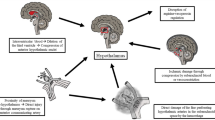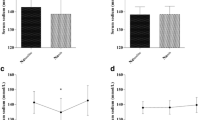Abstract
Hyponatremia is a frequent complication following subarachnoid hemorrhage (SAH), and is commonly attributed either to the syndrome of inappropriate antidiuretic hormone secretion (SIADH) or cerebral salt wasting syndrome (CSW). The object of this study is to elucidate the clinical demographics and sequelae of hyponatremia due to CSW in subjects with aneurysmal SAH. Retrospective chart review of patients >18 years with aneurysmal SAH admitted between January 2004 and July 2007 was performed. Subjects with moderate to severe hyponatremia (serum sodium <130 mmol l−1) were divided into groups consistent with CSW and SIADH based on urine output, fluid balance, natriuresis, and response to saline infusion. Clinical demographics were compared. Of 316 subjects identified, hyponatremia (serum sodium <135 mmol l−1) was detected in 187 (59.2%) subjects and moderate to severe hyponatremia in 48 (15.2%). Of the latter group, 35.4% were categorized with SIADH and 22.9% with CSW. Compared to eunatremic subjects, hyponatremia was associated with significantly longer hospital stay (15.7 ± 1.9 vs. 9.6 ± 1.1 days, p < 0.001). Subjects with CSW had similar mortality and duration of hospital stay vs. those with SIADH. Though less common than SIADH, CSW was detected in approximately 23% of patients with history of aneurysmal SAH and was not clearly associated with enhanced morbidity and mortality compared to subjects with SIADH. Further studies regarding the pathogenesis and management, along with the medical consequences, of CSW are important.
Similar content being viewed by others
References
Whiting DBG, Little J (1989) Management of subarachnoid hemorrhage in the critical care unit. Cleve Clin J Med 56:775–785
Wijdicks EVM, Van Gijn J (1990) Hyponatremia and volume status in aneurysmal subarachnoid hemorrhage. Acta Neurochir Suppl (Wien) 47:111
Wijdicks EFVM, Hijdra A (1985) Hyponatremia and cerebral infarction in patients with ruptured intracranial aneurysms: is fluid restriction harmful? Ann Neurol 17:137–140. doi:10.1002/ana.410170206
Diringer MNZA (2006) Hyponatremia in neurologic patients: consequences and approaches to treatment. Neurologist 12:117–126. doi:10.1097/01.nrl.0000215741.01699.77
Harrigan MR (1996) Cerebral salt wasting syndrome: a review. Neurosurgery 38:152–160. doi:10.1097/00006123-199601000-00035
Harrigan MR (2001) Cerebral salt wasting syndrome. Crit Care Clin 17:125–138. doi:10.1016/S0749-0704(05)70155-X
Peters JPWL, Sims EA, Orloff J, Needham J (1950) A salt wasting syndrome associated with cerebral disease. Trans Assoc Am Physicians 63:57–64
Janicic NVJ (2003) Evaluation and management of hypo-osmolality in the hospitalised patient. Endocrinol Metab Clin North Am 32:459–481. doi:10.1016/S0889-8529(03)00004-5
Tisdall MCM, Watkiss J, Smith M (2006) Disturbances of sodium in critically ill adult neurologic patients: a clinical review. J Neurosurg Anesthesiol 18:57–63. doi:10.1097/01.ana.0000191280.05170.0f
Brimioulle S, Orellana-Jimenez C, Aminian A, Vincent JL (2008) Hyponatremia in neurological patients: cerebral salt wasting versus inappropriate antidiuretic hormone secretion. Intensive Care Med 34:125–131. doi:10.1007/s00134-007-0905-7
Singh SBD, Carlotti A, Cusimano M, Rutka J, Halperin M (2002) Cerebral salt wasting: truths, fallacies, theories, and challenges. Crit Care Med 30:2575–2579. doi:10.1097/00003246-200211000-00028
Sherlock MOSE, Agha A, Behan LA, Rawluk D, Brennan P, Tormey W, Thompson CJ (2006) The incidence and pathophysiology of hyponatremia after subarachnoid hemorrhage. Horumon To Rinsho 64:250–254
Diringer MLP, Stern BJ, Schleimer J, Hanley DF (1988) Plasma atrial natriuretic factor and subarachnoid hemorrhage. Stroke 19:1119–1124
Maesaka JKGS, Fishbane S (1999) Cerebral salt-wasting syndrome: does it exist? Nephron 82:100–109. doi:10.1159/000045384
Kurokawa YUT, Ishiguro M, Hondra O, Honmou O, Kato T, Wanibuchi M (1996) Pathogenesis of hyponatremia following subarachnoid hemorrhage due to ruptured cerebral aneurysm. Surg Neurol 46:500–507. doi:10.1016/S0090-3019(96)00034-1
Adrogue HJMN (2000) Hyponatremia. N Engl J Med 342:1581–1589. doi:10.1056/NEJM200005253422107
Sivakumar VRV, Chandy M (1994) Management of neurosurgical patients with hyponatremia and natriuresis. Neurosurgery 34:269–274. doi:10.1097/00006123-199402000-00010
Palmer BF (2003) Hyponatremia in patients with central nervous system disease: SIADH versus CSW. Trends Endocrinol Metab 14:182–187. doi:10.1016/S1043-2760(03)00048-1
Sterns RH, Silver SM (2008) Cerebral salt wasting versus SIADH: what difference? J Am Soc Nephrol 19:194–196. doi:10.1681/ASN.2007101118
Treggiari MM, Walder B, Suter PM, Romand JA (2003) Systematic review of the prevention of delayed ischemic neurological deficits with hypertension, hypervolemia, and hemodilution therapy following subarachnoid hemorrhage. J Neurosurg 98:978–984
Isotani E Sr, Tomita K, Hokari M, Monma S, Marumo F, Hirakawa K (1994) Alterations in plasma concentrations fo natriuretic peptides and antidiuretic hormone after subarachnoid hemorrhage. Stroke 25:2198–2203
Berendes WWM, Cullen P, Prien T, An V, Aken H, Horsthemke J, Schulte M, von Wild K, Scherer R (1997) Secretion of brain natriuretic peptic in patients with aneurysmal subarachnoid hemorrhage. Lancet 349:245–249. doi:10.1016/S0140-6736(96)08093-2
McGirt MJBR, Nimjee SM, Friedman AH, Alexander MJ, Laskowitz DT, Lynch JR (2004) Correlation of serum brain antriuretic peptide with hyponatremia and delayed ischemic neurological deficits after subarachnoid hemorrhage. Neurosurgery 54:1369–1373. doi:10.1227/01.NEU.0000125016.37332.50
Tomida MMM, Uemera K, Yamasaki K (1998) Plasma concentrations of brain natriuretic peptides in patients with subarachnoid hemorrhage. Stroke 1998:1584–1587
Author information
Authors and Affiliations
Corresponding author
Rights and permissions
About this article
Cite this article
Kao, L., Al-Lawati, Z., Vavao, J. et al. Prevalence and clinical demographics of cerebral salt wasting in patients with aneurysmal subarachnoid hemorrhage. Pituitary 12, 347–351 (2009). https://doi.org/10.1007/s11102-009-0188-9
Received:
Accepted:
Published:
Issue Date:
DOI: https://doi.org/10.1007/s11102-009-0188-9




